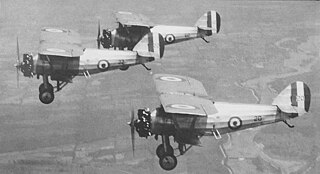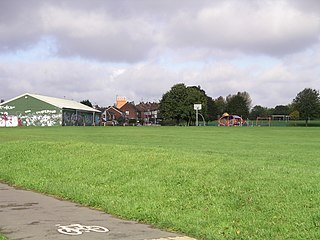
Vickers was a British engineering company that existed from 1828 until 1999. It was formed in Sheffield as a steel foundry by Edward Vickers and his father-in-law, and soon became famous for casting church bells. The company went public in 1867, acquired more businesses, and began branching out into military hardware and shipbuilding.
Matra was a major French industrial conglomerate. Its business activities covered a wide range of industries, notably aerospace, defence, automotive, motorsports, transport and telecommunications.

The British Aircraft Corporation (BAC) was a British aircraft manufacturer formed from the government-pressured merger of English Electric Aviation Ltd., Vickers-Armstrongs (Aircraft), the Bristol Aeroplane Company and Hunting Aircraft in 1960. Bristol, English Electric and Vickers became "parents" of BAC with shareholdings of 20%, 40% and 40% respectively. BAC in turn acquired the share capital of their aviation interests and 70% of Hunting Aircraft several months later.

The automotive industry in the United Kingdom is now best known for premium and sports car marques including: Aston Martin, McLaren, Bentley, Rolls-Royce, Jaguar, Range Rover, Mini and Lotus. Specialised sports car companies include: Ariel, BAC, Morgan, Caterham, AC Cars, Gordan Murray, TVR, Noble, Radical, Ginetta, Ultima Sports, Westfield, Lister, Arash and David Brown. Volume car manufacturers with a major presence in the UK include: Nissan, Toyota, Mini and Vauxhall. Commercial vehicle manufacturers active in the UK include Alexander Dennis, Dennis Eagle, IBC Vehicles, Leyland Trucks, TEVVA and the London Electric Vehicle Company.

Hawker Siddeley was a group of British manufacturing companies engaged in aircraft production. Hawker Siddeley combined the legacies of several British aircraft manufacturers, emerging through a series of mergers and acquisitions as one of only two such major British companies in the 1960s. In 1977, Hawker Siddeley became a founding component of the nationalised British Aerospace (BAe). Hawker Siddeley also operated in other industrial markets, such as locomotive building and diesel engine manufacture. The company was once a constituent of the FTSE 100 Index.

The Rootes Group was a British automobile manufacturer and, separately, a major motor distributors and dealers business. From headquarters in the West End of London, the manufacturer was based in the Midlands and the distribution and dealers business in the south of England. In the decade beginning 1928 the Rootes brothers, William and Reginald, made prosperous by their very successful distribution and servicing business, were keen to enter manufacturing for closer control of the products they were selling.

The Armstrong Whitworth Siskin was a sesquiplane single-seat fighter aircraft developed and produced by the British aircraft manufacturer Armstrong Whitworth Aircraft. It was also the first all-metal fighter to be operated by the Royal Air Force (RAF), as well as being one of the first new fighters to enter service following the end of the First World War.
Armstrong Siddeley was a British engineering group that operated during the first half of the 20th century. It was formed in 1919 and is best known for the production of luxury vehicles and aircraft engines.

Chrysler Europe was the American automotive company Chrysler's operations in Europe from 1967 through 1978. It was formed from the merger of the French Simca, British Rootes and Spanish Barreiros companies. In 1978, Chrysler divested these operations to PSA Peugeot Citroën.

Bristol Siddeley Engines Ltd (BSEL) was a British aero engine manufacturer. The company was formed in 1959 by a merger of Bristol Aero-Engines Limited and Armstrong Siddeley Motors Limited. In 1961 the company was expanded by the purchase of the de Havilland Engine Company and the engine division of Blackburn Aircraft. Bristol Siddeley was purchased by Rolls-Royce Limited in 1966.
Sir W. G. Armstrong Whitworth Aircraft Company, or Armstrong Whitworth Aircraft, was a British aircraft manufacturer.

The Armstrong Siddeley Sapphire is a British turbojet engine that was produced by Armstrong Siddeley in the 1950s. It was the ultimate development of work that had started as the Metrovick F.2 in 1940, evolving into an advanced axial flow design with an annular combustion chamber that developed over 11,000 lbf (49 kN). It powered early versions of the Hawker Hunter and Handley Page Victor, and every Gloster Javelin. Production was also started under licence in the United States by Wright Aeronautical as the J65, powering a number of US designs. The Sapphire's primary competitor was the Rolls-Royce Avon.

John Davenport Siddeley, 1st Baron Kenilworth, was a pioneer of the motor industry in the United Kingdom, manufacturing aero engines and airframes as well as motor vehicles.

The Siddeley-Deasy Motor Car Company Limited was a British automobile, aero engine and aircraft company based in Coventry in the early 20th century. It was central to the formation, by merger and buy-out, of the later Armstrong Siddeley Motor and Armstrong Whitworth Aircraft companies.

Whitley is a suburb of southern Coventry in the West Midlands of England and a major centre of the British automotive corporation Jaguar Land Rover. The name Whitley is said to mean "from the white meadow".

The Armstrong Siddeley Jaguar is an aircraft engine developed by Armstrong Siddeley. The Jaguar was a petrol-fuelled air-cooled 14-cylinder two-row radial engine design. The Jaguar III was first used in 1923, followed in 1925 by the Jaguar IV and in 1927 by the Jaguar VI. In 1925 the Jaguar became the first production aero engine incorporating a geared supercharger.

The Midland Air Museum (MAM) is situated just outside the village of Baginton in Warwickshire, England, and is adjacent to Coventry Airport. The museum includes the Sir Frank Whittle Jet Heritage Centre, where many exhibits are on display in a large hangar. It also has a small hangar, and a fenced-off green area where many aircraft are on display in the open.

Jaguar Land Rover Automotive PLC is the holding company of Jaguar Land Rover, also known as JLR, and is a British multinational automobile manufacturer which produces luxury vehicles and SUV and has its head office in Whitley, Coventry, United Kingdom. The principal activity of Jaguar Land Rover is the design, development, manufacture and sale of vehicles bearing the Jaguar and Land Rover marques.

The Ryton plant is a former car manufacturing plant in Ryton-on-Dunsmore, England. Developed by the Rootes Group as a shadow factory in 1939 to produce aircraft engines for World War II; post war it became the headquarters of the group.
The Jaguar Land Rover Gaydon Centre, which is situated north-west of the village of Gaydon, Warwickshire, England, is one of the principal engineering centres of Jaguar Land Rover and the location of the headquarters of Land Rover. The site houses a design, research and development centre and extensive test track facilities and is used for the design and development of Jaguar and Land Rover vehicles. The site, along with the smaller Aston Martin facility adjacent, occupies the land that was once the RAF V bomber base of RAF Gaydon. The British Motor Museum is also located on the same site.



















